Mystery within Mystery: E.
Burke Collins and "Dare the Detective"
by Deidre A. Johnson
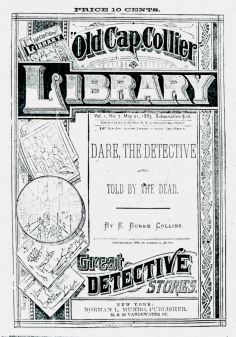
Studies of dime novels
frequently approach the material either by genre (such as detective
fiction, westerns), as reflections of the culture that produced them,
or, in recent years, through a feminist lens. One perspective only
infrequently used is biographical, considering connections between an
author's life and fiction, yet awareness of an author's background
can provide additional context for understanding a work. In the case
of dime novels, this approach may also allow examination of the
effect of overlaying autobiographical elements on formulaic material.
A look at "Dare the Detective; or, Told by the Dead"
by E. Burke Collins,
an early issue of Norman L. Munro's detective dime novel series Old
Cap Collier Library,
offers one example of the potential of this method.
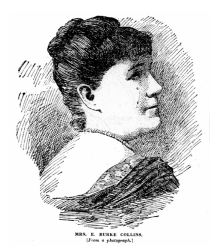
Traditionally, mysteries
involve unveiling secrets, solving crimes by bringing deceptions and
hidden elements to light. Using a biographical approach for "Dare
the Detective" reveals that the first deception occurs on the
cover with the author's name. Although the name appears masculine,
the author was actually a woman, twice-widowed Mrs. Emma Skelton,
whose first husband had been Emmett Burke Collins (and another
mystery, still unsolved, is whether the E was intended to represent
her first husband's Christian name or her own). She used the names
E. Burke Collins and Mrs. E. Burke Collins for her fiction, the
vacillation perhaps indicative of the dual position many 19th-century
women writers occupied, striving simultaneously to retain their
femininity while forced to adopt a traditionally masculine role by
earning a living. With "Dare," the decision to mask
Collins's gender may also have been occasioned because she was
writing in the predominantly masculine fields of dime novels and
detective fiction. Collins's use of the name E. Burke Collins, is,
however, also reflective of other aspects of her life and fiction.
The name -- a partial pseudonym, since she was not, in fact, even
Mrs. E. Burke Collins at this point -- concealed, altered, and yet
also gave clues to her identity. Similarly, Collins regularly
concealed certain aspects of her life and altered others when
providing information -- or clues to her history -- for biographical
sketches. Even when not in the mystery genre, her fiction often
includes deceptions and disguises, plot reversals (in essence,
revisions of established situations), and indications that all is not
as it seems. It also places women in prominent roles, often in
situations requiring them to assume a male character's
responsibilities.
In order to appreciate
Collins's use of autobiographical elements in "Dare the
Detective," some background on her life is necessary. She was
born Emma Augusta Brown in Rochester, New York, on 15 September 1848
-- not 1858, the date
given in all published biographies. She began concealing her true age
a few years before "Dare the Detective" was published, and,
by 1893, when her biographical sketch appeared in A
Woman of the Century, had
altered her age by a full 10 years. [1]
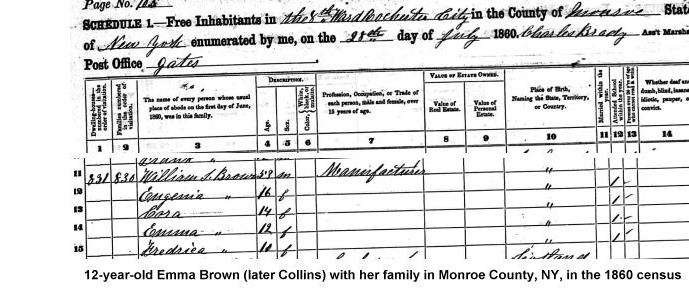
The third of four daughters
born to W. S. and Harriet Amelia (Whiting) Brown, Collins became a
half-orphan at eight and was raised in a single-parent household by
her father. [2] At 19 (not 15, as in some accounts), she married
Emmett Burke Collins, a disabled veteran who had fought in the Union
Army. [3] A year later, she gave birth to a son, who lived only five
days and was buried in Rochester's Mt. Hope cemetery. [4]
Shortly before their marriage,
Emmett, an attorney, had successfully run as the Republican candidate
for the local Justice of the Peace. His March 1870 bid for
re-election failed, however, perhaps undermined by vague allegations
and slurs printed in a local newspaper, the Rochester
Union and Advertiser, which
firmly supported the Democratic ticket. [5] (The same paper had
published an anonymous letter accusing Emma's half-brother of
criminal activities four years earlier, when he had been nominated
for Alderman.) [6] The 1870 census, taken that June, found Emma and
Emmett sharing a home with her two sisters, her half-brother, and
their spouses. [7]
In 1871, Emmett and Emma
Collins moved to Ponchatoula, Louisiana, about 47 miles northwest of
New Orleans. Emmett's father, Simri Collins, had recently purchased
a plantation in the area. [8] Within a year, Emmett was dead, victim
of what was described -- slightly differently in each account -- as a
shooting accident. His body was shipped back to Rochester for burial
near their son in Mt. Hope cemetery. [9] Emma, who had earlier
dabbled in writing for amusement, now decided to adopt it as a career
and even tried -- unsuccessfully -- to establish a literary
magazine. [10] In 1879, she remarried, to James F. Skelton, a
Louisiana native five years her junior, and took up residence in New
Orleans; less than two years after her marriage, she was again a
widow. [11] Skelton is, biographically speaking, Collins's invisible
husband, his existence virtually erased from her history.
Biographical sketches -- most appearing after her October 1884
marriage to Robert R. Sharkey -- name only Collins and Sharkey as her
husbands; some even refer to Sharkey as her "second husband".
[12]
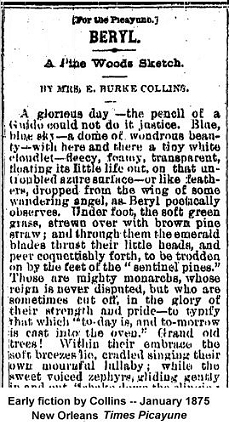
For much of her time in
Louisiana, Collins maintained two residences -- one, a house in New
Orleans (shared with her second husband's parents after his death),
and a second in Tangipahoa, a town about 30 miles north of
Ponchatoula. [13] A prolific writer, Collins published poetry, short
stories, and serials (primarily romances). Her early fiction
appeared in newspapers such as the New
York Clipper and the
New Orleans Times
Picayune. In the
1880s and 1890s, four of the major story papers carried her work
(Street & Smith's New
York Weekly, James
Elverson's Saturday
Night, George Munro's
Fireside Companion,
Norman Munro's New
York Family Story Paper).
[14] Since her history after 1883 does not affect "Dare the
Detective," the only other elements that should be noted --
because they are not included in bibliographic records or
biographical sources -- are that she moved to Hendersonville, North
Carolina, about 1898 and died there on May 6, 1902. [15]
"Dare the Detective"
-- a serious contender for most convoluted mystery ever published in
OCCL (or
elsewhere, for that matter) -- appeared on May 21, 1883, as number 7
in the series. It had originally been serialized under the same
title in Munro's New
York Family Story Paper from
Nov. 15, 1880, to
Jan. 17, 1881
(#371-380). [16]
Collins clearly draws on autobiographical elements for the opening
scenes and several other elements. The story begins in her hometown
of Rochester, where Philip St. Aubyn is unexpectedly confronted by a
woman, Gabrielle. Gabrielle accuses him of marrying her then
abandoning her on a small plantation in Louisiana and returning to
Rochester -- a situation metaphorically paralleling Collins's own.
Philip confesses that he has concealed their marriage and
(bigamously) wed his cousin Norma to keep his family's fortune.
Clutching proof that she is his legal wife, Gabrielle leaves. Sadly,
she fares no better on her trip north than Mrs. Collins's first
husband did in his move south: the next day she is found apparently
frozen to death (a symbolic suggestion of the inhospitable climate?).
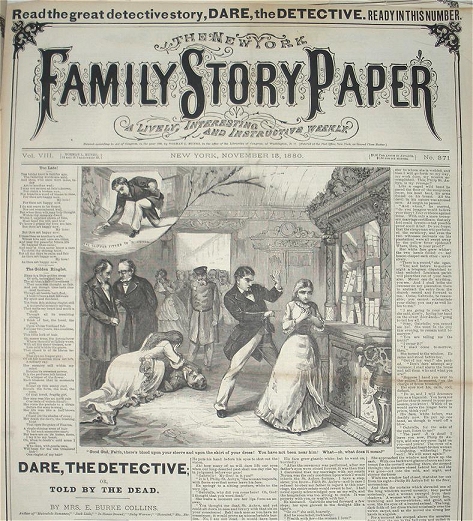
Philip promptly destroys all
evidence of their marriage, but he does not live long enough to enjoy
his triumph: the following day, the servants discover his body.
Darrell (Dare) Renshawe -- betrothed to the victim's half-sister
Faith (who, like Collins in 1870, lives with her half-brother and his
spouse) -- arrives to investigate and, to his horror, instead
implicates Faith in the murder. Before Faith can be arrested, she,
too, dies, and, along with Philip, is buried in Mt. Hope Cemetery,
the same cemetery that housed Collins's relatives.
Devastated, Dare is taken home
to be cared for by his family. Like Collins in her youth, he lives
in a single-parent household, although Dare's relatives are all
female -- two younger sisters and a mother. Violet-eyed Pearl, the
youngest sister (and the child whose birth order corresponds to that
of Collins), has an unusual gift: she is clairvoyant. She tells
Dare that she knows Faith's grave is empty; thus, Faith is still
alive. Dare sets off to investigate and is promptly captured by
Norma St. Aubyn. Although she is not a detective, Dare's other
sister, Barbara, takes up the investigation. She persists even when
a detective shows her an article from the local newspaper falsely
alleging that Dare has fled after committing a crime (a situation
reminiscent of Collins's family's problems with the Rochester
newspaper). Barbara goes to the Arcade Building (possibly Smith's or
Reynold's Arcade, where Collins's husband and father-in-law had
offices), to confront the lawyers named in the newspaper article.
[17]
Collins's knowledge of
Louisiana institutions informs the next segment of the story, as the
scene switches to the Office of the Parish Recorder in a small town
in Louisiana. Jasper Jennings, overseer of Philip St. Aubyn's
Louisiana plantation, tricks Silas Latham, the clerk, into leaving
him alone with a volume holding records of marriage, then pours an
ink-dissolving chemical onto Philip St. Aubyn's entry, essentially
erasing the record of the marriage. Later, at the Lathams' home,
Jasper meets with Gabrielle (who helpfully explains that a Rochester
doctor "fancied he saw signs of life" and resuscitated her,
then agreed "to keep it a secret") [18]. Jasper tells
Gabrielle "that in many portions of the South, it is the custom
. . . for the officiating clergyman to present a certificate of the
marriage to both the bride and the groom" (21). He has
acquired the groom's certificate, the only remaining evidence of the
marriage (which would allow Gabrielle to claim the St. Aubyn fortune
for herself and her infant daughter).
The last half of the story
contains fewer recognizable autobiographical elements. It does
include several key scenes at the train depot in the Lathams' small
(unnamed) Louisiana town, suggesting some correspondence to
Ponchatoula or Tangipahoa, both of which, in the 19th century, were
stops on the Illinois Central Railroad (formerly the New Orleans,
Jackson, and Great Northern Railroad). As in the story, the railroad
connected those towns with New Orleans, and one of the memorable
events in Ponchatoula's history was an 1862 train collision that left
over 100 Confederate soldiers dead or injured. [19] In "Dare,"
after leaving the Lathams' home, Gabrielle boards a southbound train
that crashes near a small town -- which, if the Lathams were in
Tangipahoa, would place the wreck near Ponchatoula. There she
discovers her kidnapped daughter's grave, another association of loss
with that location. A few details in the novel's final scenes, back
in Rochester, again indicate Collins's familiarity with the city:
when the text mentions that Dare's fiance, Faith (who, like Gabrielle
and her child, was actually alive and in hiding) is in jail pending
trial, it includes the actual name of the building, the Blue Eagle
Jail.
Several other elements, while
not specifically tied to locations, nonetheless suggest
autobiographical connections. One of the few times the narrative
voice shifts into a direct address to the reader -- as if the
narrator were speaking from experience -- occurs after Gabrielle
learns her infant daughter is actually alive. Collins writes,
"[Gabrielle] could only kiss the baby face and weep such tears
as you mothers would shed, could your little one whom you had laid
away under the sod a short time ago be suddenly and miraculously
restored to your arms." (42) Here, as throughout the story,
lovers and children who appear to have died and been buried are
instead discovered alive and reunited with their families, the
ultimate in wish-fulfillment for a woman who had lost a husband and a
child. Also of interest is the resolution of the story: at the
trial, Dare's sister Pearl -- the character who might be considered a
stand-in for Collins -- falls into a clairvoyant trance. Dare
persuades the court to allow Pearl to speak from her trance and she
describes her vision of the crime. So powerful is her recounting of
events that Norma, the murderer, confesses. Thus, ultimately, it is
Pearl's ability to envision and describe a scene that brings about
the successful resolution, just as it was Collins's ability to
imagine and narrate an absorbing story that created a satisfying
experience for her readers and led to her own success.
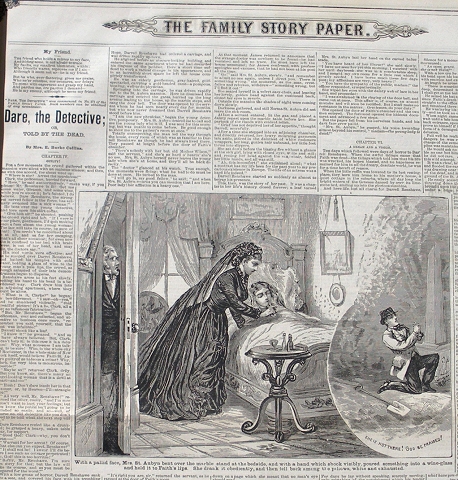
Pearl's role also illustrates
another element that distinguishes Collins's story from many of the
other mysteries in Old
Cap Collier Library --
the role of women. Despite the use of a male's name for the title,
female characters dominate the narrative, and their actions
frequently drive the plot: Gabrielle's appearance sets the story in
motion; Norma's response -- murdering her husband and then working to
conceal evidence and quash the investigation -- shapes much of the
remainder of the work. Dare does not appear until halfway through
the second chapter, and his investigation is surprisingly
ineffective. Deciding to use technology (a masculine element), he
hires a man to take a daguerreotype of the victim's retina,
theorizing it will retain an image of the last person Philip saw,
presumably the murderer. [20] The result instead erroneously
implicates Faith. Having botched the investigation and failed to
protect Faith, Dare is borne "home to his mother's house"
after Faith's funeral and "[f]or days he lay without speaking,
scarcely moving," being cared for by his female relatives (10) .
Eventually resuming the case, he is almost immediately imprisoned by
Norma and spends the next nine chapters trapped while his sister
Barbara pursues the investigation. (Indeed, as she captures Dare,
Norma remarks, "a woman's wit is keener than a man's in an
emergency like this" [p.12].) Dare finally reappears, only to
spend most of the next ten chapters in disguise (and, although it is
evident to anyone familiar with the genre that the mysterious Signor
Ravelli is actually Dare, his identity is not actually revealed until
the last three pages). One character who does know the truth about
Dare's hidden identity is Barbara, just as, throughout the story, it
is the female characters who possess crucial information or
instinctively recognize the truth of a situation. Unlike the male
detectives on the case, Norma and Faith are both aware of the
identity of the murderer for the entire story. Similarly, unlike
Dare's male co-workers, Barbara never doubts Dare's innocence and
quickly begins investigating the true culprit, Norma. Pearl not only
sees through the deception about Faith's death but also, at the
trial, proves that a female clairvoyant's vision is a better gauge of
the truth than the physical evidence assembled by the male detectives
and prosecuting attorneys.
Dare
is also in many ways a surprisingly feminine detective. He is
introduced as "[a] man of perhaps five-and-twenty, but with a
beardless, boyish face" (4). Thus, the first description notes
his "beardless" state -- in other words, he lacks the
visible marker of masculinity. During the brief time he conducts his
initial investigation, Dare's behavior also allies him with the
feminine: he moves about the scene of the crime "serenely,"
speaks "quietly" to the officials and "tenderly"
to Faith (4). Attempting to gather additional evidence, Dare
disguises himself as a peddler and charms Norma's maid with his
wares: "really pretty laces, ribbons, jewelry, combs --
everything calculated to dazzle the feminine eye" (5). The clues
he collects in that scene seem more fitting for Nancy Drew than a
dime novel detective: "a tiny circlet of gold . . . the remains
of a gold locket" and "a pair of tiny, white satin
slippers" (6). Later, when Dare realizes his investigation has
made Faith appear guilty of Philip's murder, he faints -- or, as the
policeman at the scene puts it, Dare "swooned like a sick
woman." (7)
Even the resolution of the
story suggests a triumph for females and a blurring of genres. Norma
inexplicably drops dead at the trial and is buried, but since every
other female character who appeared dead was ultimately revealed to
be alive (indeed, the only permanent corpses in the tale are the two
males, Philip and Jasper), it is possible to assume yet another
medical misreading, especially since there is no apparent cause of
death. As for the other characters, the final three paragraphs
introduce three weddings -- Gabrielle and the doctor who saved her,
Barbara and Philip's best friend (a detective involved in another
aspect of the investigation), and Faith and Dare. Rather than
celebrating the solution to the case, those paragraphs emphasize the
romantic resolutions, and the story's final sentence
highlights/spotlights Dare's acquisition of domestic bliss: "And
in all Rochester there is no home more happy because of the true
hearts within it than the home of Faith and her husband -- Dare, the
Detective." (48)
Reading "Dare the
Detective" with an awareness of Collins's life indicates that
Collins drew on her own experiences when crafting the story, a trait
evident in a number of her other writings as well. Familiarity with
Collins's background thus offers another perspective for considering
some of the authorial decisions in the novel -- everything from the
choice of setting to plot twists and blending of genres and gender
roles. While a biographical approach may require penetrating the
identity behind a pseudonym, and, in some cases, reconstructing the
life of a lesser-known author, it may also provide a useful angle for
additional examination of a text.
Notes
The author gratefully acknowledges the invaluable
assistance of Lydia C. Schurman and J. Randolph Cox, without whose
help this article would not have been possible. It was Dr. Schurman
who first acquainted me with E. Burke Collins and generously shared
her research material. J. Randolph Cox kindly provided a copy of
"Dare the Detective" and additional information on dime
novel research. Special thanks are also due to Tracie Meloy, Neal
Kenney, and Gail Dotson of West Chester University's Interlibrary
Loan office for locating copies of elusive newspaper articles and
reference sources.
1. The Sept. 15, 1848, birthdate appears in Hal
Hileman, Ancestry World Tree Project: Hileman Mail File 13
<http://awt.ancestry.com/cgi-bin/igm.cgi?op=GET&db=:3200703&id=I5432>.
Emma Brown, age two, appears in the 1850 United States Federal
Census, Rochester Ward 8, Monroe, NY; Roll M432_531, page: 375,
image: 302, accessed via ancestry.com. Emma Brown, age twelve, is in
the 1860 United States Federal Census, Rochester Ward 8, Monroe, NY,
Roll: M653_783, page: 791, image: 319, accessed via ancestry.com.
"Sharkey, Mrs. Emma Augusta," in A
Woman of the Century: Fourteen Hundred-Seventy Biographical Sketches
Accompanied by Portraits of Leading American Women in All Walks of
Life, eds. Frances E. Willard and Mary A.
Livermore (Buffalo: Charles Wells Moulton, 1893), also gives
Collins's birthdate as Sept. 15, but the year as 1858 (646).
2. Hileman and the census records provide some
information about the family members. The year of Collins's mother's
death is listed in Mt. Hope & Riverside Cemetery Records,
.
3. "Married." Rochester
[NY] Union &
Advertiser, Sept. 20, 1867: 3; John C.
Bonnell, Jr., Sabres in the Shenandoah: The
21st New York Cavalry 1863-1866 (Shippensburg,
PA: Burd Street Press, 1996): 58, 270, 300, 330, 367.
4. Collins's son is listed in Mt. Hope & Riverside
Cemetery Records.
5. "Republican City Nominations," Rochester
Union and Advertiser, March 4, 1870; the
date of the 1867 campaign is from Rochester NY History - Monroe
County (NY) Library System, Index to Newspapers Published in
Rochester, New York, 1818-1897, "Book 13" [1851-1897
COA-COR].
"E. Burke Collins," Rochester Union
and Advertiser, March 4, 1870. For the Union
& Advertiser's Democratic allegiance, see William F. Peck,
Semi-Centennial History of Rochester
(Syracuse NY: D. Mason & Co., 1884):
347-53.
6. "An Eighth Ward Republican, "The Republican
Nomination for Alderman in the Eighth Ward." Rochester
[NY] Union & Advertiser,
6 March 1866: 2.
7. 1870 United States Federal Census, Rochester Ward 8,
Monroe, NY, Roll: M593_969, page: 380, image: 763, accessed via
ancestry.com.
8. "Real Daughter 94 Years Old," Nebraska
State Journal, 22 Aug 1908: 10; "Death
of E. B. Collins," Rochester Daily Union
& Advertiser, 19 Feb 1872: 2.
9. "Fatal Accident," Times
Picayune, 13 Feb. 1872; "Crimes and
Casualties," Troy [NY]
Weekly Times, 24 Feb
1872: 2; "Death of E. B. Collins"; Aaron Zschau, "Collins
Memorial,"
10. "Sharkey," A
Woman of the Century, 646.
11. Louisiana Marriages, 1718-1925 Hunting For Bears,
comp. [database on-line] , via ancestry.com; 1880 United States
Federal Census, 8th Ward, Tangipahoa, LA, Roll: T9_471, enumeration
district 182, image: 0784;via ancestry.com. "Died" [James
F. Skelton obituary], New Orleans Daily
Picayune, 10 April 1881: 6. Special thanks
are due to the staff of the Louisiana Division, Special Collections,
at the New Orleans Public Library for their help with research in
their collection.
12. See, for example,"Notes," The
Critic, 21 April 1888: 198;
E[ric] B[raddon] [William J. Benners], "Emma
Collins Sharkey," The Magazine of Poetry
6 (1894): 214;
"Sharkey, Mrs. Emma Augusta," Herringshaw's
National Library of American Biography, vol.
5 (Chicago: American Publishers' Association, 1914). Skelton is
mentioned in Collins's obituaries, but since her death received so
little notice that it is not included in any biographical sketches or
cataloging records, the information essentially remained hidden.
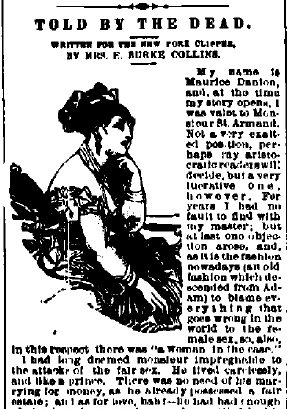
13. See, for example, listings for Skelton (Emma,
Justine, and William) and Robert Sharkey in Soards'
New Orleans City Directories for 1882, 1883,
1887; for Sharkey in A Directory of Writers
for the Literary Press, 3rd. ed. (Bangor, ME:
W. M. Griswold), 1890; "Sharkey," A
Woman of the Century, 647.
14. "How to Sell Stories," Inter
Ocean, 22 Jan. 1888: 10; J. Randolph Cox,
email, 19 May 2009, on the prominence of the papers.
15. [Emma Collins Sharkey obituary] Rochester
Democrat and Chronicle, 23 May 1902: 4.
16. The serial was published as by Mrs.
E. Burke Collins (J. Randolph Cox, email, 19 May 2009), again perhaps
suggesting that the publisher felt the dime novel series was aimed at
an audience that would expect a male author, unlike that of the
"family" story paper.
17. Andrew Boyd, Boyd's Business
Directory of Over One Hundred Cities and Villages in New York State,
1869-70. Albany: Charles Van Benthuysen &
Sons, 1869.
18. E. Burke Collins [Emma Augusta Brown Collins],
"Dare the Detective; or, Told by the Dead," Old
Cap Collier Library, vol. 1, no. 7, 21 May
1883: 20. All future references will be parenthetical in the text.
19. "Railroad Disasters," Daily
Dispatch 10 March 1862: 1; "Jackson
Railroad Report," [New Orleans] Daily
Picayune, 16 April 1862: 2; Lawrence E.
Estaville, Jr., "A Strategic Railroad: The New Orleans, Jackson
and Great Northern in the Civil War," Louisiana
History: The Journal of the Louisiana Historical Association 14.2
(Spring, 1973): 117-20.
20. The idea that a daguerreotype could reveal a
murderer (and that it preserved the last image seen by the deceased)
was briefly popular in the 19th century. The
American Journal of Education and College Review 2
(1856), for example, reprinted a paragraph from the New York Herald
to that effect (476). The concept also
figured in a short story, Claire Lenoir,
published in France in 1867 (Simon Ings, A
Natural History of Seeing [W. W. Norton &
Co., 2008]: 54). Whether Collins was familiar with the story is not
known , but Gabrielle in "Dare" has a strikingly similar
surname -- Le Noir (22). Collins was apparently intrigued by the
concept of the revelatory retinal daguerreotype, for she also
employed it in an earlier story, whose title was actually used as the
subtitle of "Dare the Detective" ("Told by the Dead,"
The New York Clipper,
14 July 1877: msg. pg.).
Copyright 2013 - Deidre Johnson
Originally published in Dime Novel Round-Up October 2009
Return to main page





